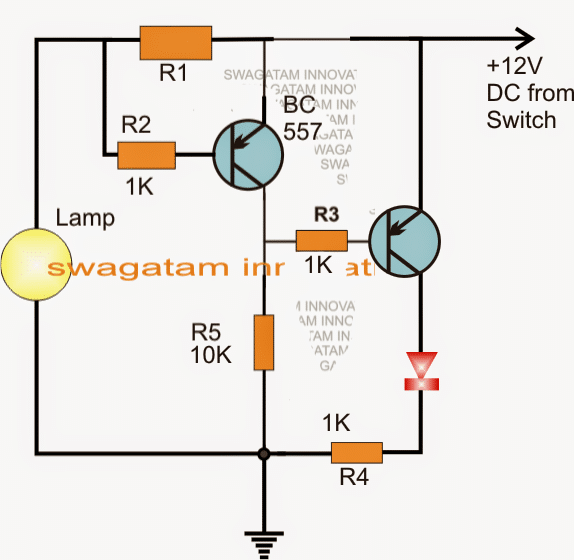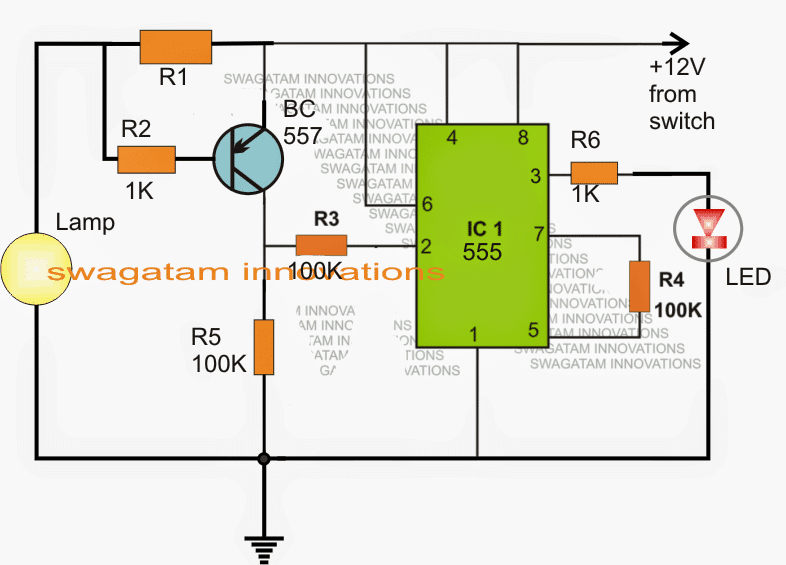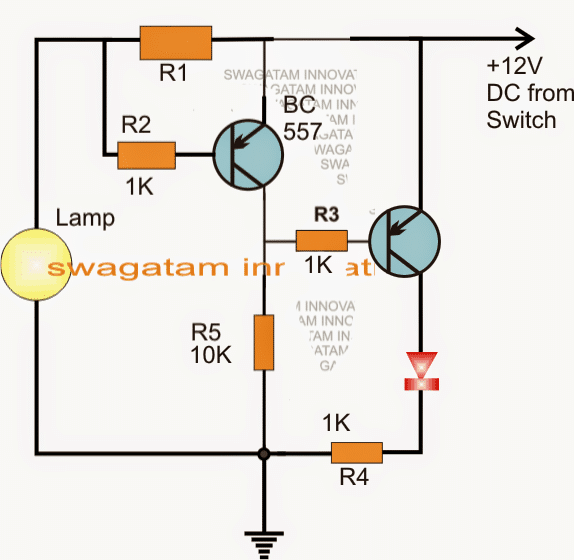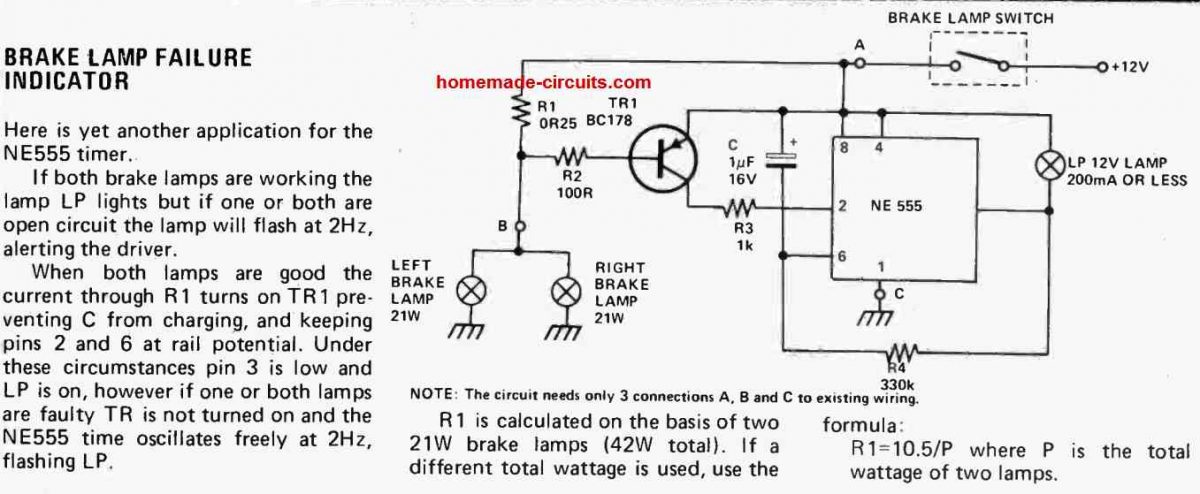
In this post I have explained a simple fused or blown car brake light indicator circuit using a single IC 555 and a few other passive components. The idea was requested by Mr. Joel Bayongasan
Technical Specifications
You innovations are great! Thanks for this blog. May I request something please? I was searching for a circuit that will detect a blown brake lamp.
A car normally, there two connected in parallel or sometimes four.
I am looking for a circuit that would light an led indicator if one of the bulbs is busted. I hope you can help.
Thank you.

The Design
By introducing the above shown circuit between the lamp and the supply, the intended blown brake light bulb indicator can be easily built and implemented in any vehicle.
The functioning is quite straightforward:
The IC 555 is configured as a simple voltage comparator, where its pin2 becomes the sensing input.
The BC557 along with the associated R1, R2 resistors forms a current to voltage converter stage.
Using Resistor Sensor
As long as a working bulb lamp stays connected across the shown points, a small negative potential corresponding to the bulb current consumption is developed across Rx.
This potential becomes sufficient to keep the BC557 triggered and conducting which in turn keeps pin2 of the IC high.
With the above conditions, pin3 of the IC stays low and the LED remains shut off.
However in an event the car bulb fuses or stops illuminating, the potential across Rx vanishes or reduces to an extent where the BC557 just stops conducting.
This instantly renders pin2 of the IC high and the LED begins glowing indicating the blown brake light bulb situation to the user.
The above design can be also effectively used in many different applications which require some kind of current (amp) monitoring such as an over-current or over-load cut off etc.
R1 may be calculated as follows:
R1 = 0.7/bulb current rating
The above explained circuit can be much simplified through the following configuration:
Simplified Schematic

Using Reed Relay Switch
The above discussed blown car lamp, broken car lamp indicator circuit can be also implemented using a simple reed relay circuit as I have explained below:
How the Circuit Works
The reed circuit I have explained in this article, is made up only one reed-relay, a single LED and one resistor. It offers a less expensive blown lamp alert technique.
A LED is installed in a appropriate place around the dashboard, and it is switched OFF as soon as the concerned lamp malfunctions. It is obviously feasible to utilize many such circuits to keep track of various lamps or sets of lamps. The circuit (figure 1) functions by supplying the current to a lamp via the working coil of a reed-relay.

In case a specific lamp fuses, the current immediately drops, causing the reed relay to open up and switching OFF the LED. The quantity of wire turns on the working coil must be such that its closes the reed contacts efficiently through the standard working current of the lamp, and still small enough to ensure that the reed relay is able to opens out when of lamp happens to blow.
Usually, a reed relay needs around 30 to 100 AT (ampere turns = current x no. of turns). Therefore, considering the reasonably high level of currents utilized by car lamps, within this specific application the coil on the reed may contain just a few turns only. For instance, the two car headlamps pull a current of around. 7.5 A (at 12 V).
A reed-relay having specification of 50 AT might consequently need just seven turns to display the current of each headlamps. If either of the lamps burn, then the current via the reed coil drops to around one half, resulting in the reed to deactivate and the dashboard LED to become switched OFF.
The circuit demonstrated in figure 2 is an alternate model that makes the LED illuminate if a lamp requires replacing.
This allows a bolder warning specifically at nighttime. Nevertheless the circuit in figure 1 is also failproof.
To make sure that the caution technique works correctly, it's advocated that an independent reed relay is employed to keep track of lamps of varying wattage, i.e. separate reed switches for the back lights, brake lights, headlamps etc.
Additionally it is likely to utilize a solitary relay to screen each right and left turning signals with a double winding around the coil.
Nevertheless, it isn't recommended to make use of one particular relay to monitor a circuit or combined circuits that has in excess of two lamps can be ' turned ON ' at the same time, the circuit of figure 2 is utilized then the supply to the LED must be obtained from the switched part of the lamp supply.
This makes sure that when the relay disconnects out because of the lamp getting powered down the LED doesn't illuminate, because its power is additionally shut off. It is essential to notice that the winding thickness employed to wrap the relay coil must be a minimum of as heavy as that found in the actual car wiring, to reduce the voltage drop over the coil and likely overheating.
Brake Light Failure Monitor Circuit
Below shown is another blown brake light indicator using the IC NE555 timer. When the two brake lamps are functioning, the lamp LP remains illuminated. However when any one of the lamps or both the brake lights tend to be burn creating an open circuit the lamp LP begins blinking at 2Hz frequency, which is enough to signal the driver regarding a brake light failure.

When both the rear lamps work in a sound condition, the current passing by means of R1 activates TR1 blocking capacitor C from charging, which allows the pins 2 and 6 at the supply potential. In these situations pin 3 of the IC is held low which keeps lamp Lp illuminated. On the other hand if a single or the two lamps become faulty TR does not get switched on, which allows the NE555 IC to oscillates continuously at 2Hz, causing the lamp LP to flash.


With over 50,000 comments answered so far, this is the only electronics website dedicated to solving all your circuit-related problems. If you’re stuck on a circuit, please leave your question in the comment box, and I will try to solve it ASAP!